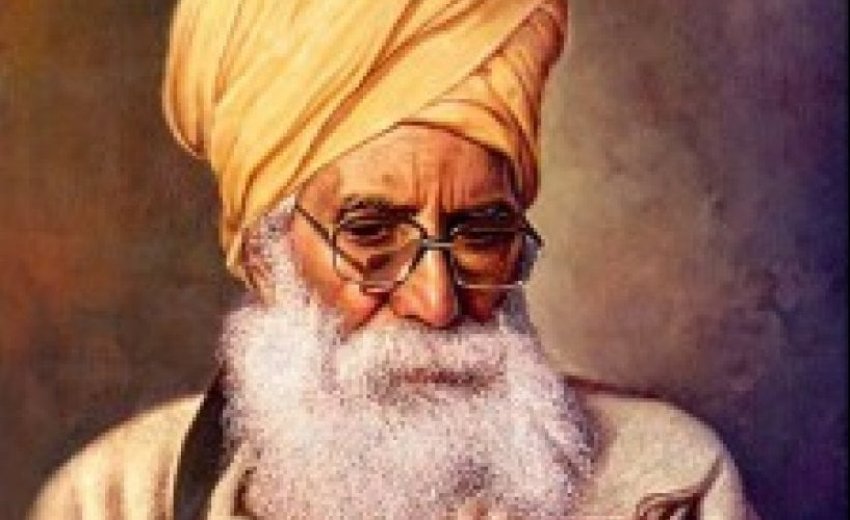"Garland Around My Neck: The Story of Puran Singh of Pingalwara" by Patwant Singh and Harinder Kaur Sekhon is a biography of Puran Singh Ji,and the story of the creation of Pingalwara, a refuge dedicated to the indigent and underprivileged, often referred to as "The Leper Colony.". They called him Bhagat ji, which means "God's Devotee" .This book narrates the profound connection between Bhagat Ji's life and the history of Pingalwara. It's a story of how someone who was homeless made a home for others - a place for people with nowhere else to turn. This is a touching story that can touch even the coldest hearts and make them feel the happiness that comes from helping those who are suffering and forgotten.
Viewpoint of the authors on Bhai Puran Singh Ji
At the beginning of the book, the authors take a few pages to talk about the history of Spirituality and Religion in Punjab and India. They go all the way back to the time of Buddha and Guru Nanak, and this helps us understand the background of Bhagat Puran Singh Ji's work. This is especially helpful for those who may not know much about where he came from.
In the 20th century and even today, many people in India are poor and homeless. A big reason for this is the Hindu caste system, which causes a lot of suffering and leaves many people with nowhere to go. At that time, many people believed that beggars and the handicapped on the streets couldn't be helped. But Bhagat Puran Singh Ji proved them wrong. He spent his whole life helping these people, giving them a home and a reason to hope, even when others had given up on them. The book provides insights into the life of Bhagat Puran Singh Ji, spanning from his birth to his final days. Given the scarcity of written records from that era, the authors had to rely on personal accounts from individuals who had the privilege of knowing him personally to uncover the details of his life.
Bhai Puran Ji’s early life
Puran Singh Ji, born to Chibu Mal, a wealthy Hindu money-lender, and Mehtab Kaur, a young widow he was betrothed to in a special ceremony called "chadar," had a unique beginning. When Mehtab Kaur was pregnant with Puran, Chibu Mal considered ending the pregnancy due to past hardships. However, Mehtab Kaur passionately requested to let the child be born, with the condition that this child would never claim any of Chibu Mal's possessions or interfere with his love for his other family.
From his early years, Puran was deeply influenced by the Sikh values instilled by his mother, Mehtab Kaur. She taught him the importance of humility, selflessness, and seva (service), a profound love for humanity, animals, and the environment. These teachings left a lasting mark on Puran's life. Mehtab Kaur led by example, encouraging Puran to pick up harmful objects from the road, like bricks and glass, emphasizing the value of small acts of kindness. She also instilled in him a strong belief in treating all people with respect and serving others. On her deathbed, she extracted a promise from him to dedicate his entire life to serving others, a promise that Puran would faithfully keep throughout his lifetime.
Bhagat ji's life journey to create Pingalwara
Against all odds, he tirelessly took on the immense task of caring for the suffering, handling everything from cleaning wounds to faeces, all on his own for years before any assistance arrived. Despite constant financial struggles, he persevered. The mission of Pingalwara, often misunderstood as a home for the disabled, was actually inspired by Puran Singh Ji's observation that while wealthy donors readily funded hospitals, they showed little concern for dying individuals on the streets.
Puran Singh Ji's vision for helping the destitute and disabled was born during his seva at a gurdwara.
"An old man with a badly infected leg limped into the gurdwara one day. Puran Singh, on seeing maggots oozing out of a very small hole in his calf, took him to Lahore's Mayo Hospital - the biggest in undivided (pre-Partition) Punjab. The ailing man was admitted and given a proper bed with clean sheets to sleep on. At this, he gratefully remarked, ‘I know I am going to die soon. But at least here I will die with dignity.'"
He learned a valuable lesson from the incident: that every person deserves to live and pass away with dignity. Four years after his mother's passing, a significant moment arrived in his life. In 1934, he discovered Piara, a young boy of around four years old, who was mute, mentally challenged, physically deformed, and suffering from severe dysentery. The child was in a deplorable state, covered in flies and his own waste. Puran Singh Ji brought Piara to the gurdwara and diligently cared for him. From that day onward, they became inseparable for the next 14 years. Puran Singh Ji literally carried Piara on his back every single day during those years.
Puran Singh Ji's inspiration to keep going was Piara, whom he considered the "garland around his neck"
The Partition of Punjab
When the partition of Punjab and India took place in 1947, Bhagat Puran Singh Ji found himself travelling from Lahore to Amritsar. He made a decision to settle down in Amritsar and establish a home for those who were destitute and disabled. As time went on, more people in need sought refuge with him, and he tirelessly searched for better shelters. Over the years, Bhagat Puran Singh Ji and his charges moved from abandoned homes to movie theatres and even bus stands in search of suitable accommodations.
As the word spread about this compassionate man caring for many "cripples," donations started coming in. Donation boxes were placed around the city, including at the Darbar Sahib (Golden Temple, Amritsar). Slowly but steadily, he began receiving small grants from organizations like the S.G.P.C. (the Shiromani Gurdwara Prabhandhak Committee) and private donors.
The land of Pingalwara
Eventually, the Government of Punjab provided him with a piece of land to build a permanent shelter for those under his care. However, Puran Singh Ji envisioned more than just another hospital; he believed that while fully-equipped hospitals already existed, what the common people truly needed was greater boarding facilities, as they could always seek outdoor treatment from existing hospitals.
The inmates at Pingalwara were provided with essential necessities like food, clothes, and a comfortable bed to sleep in. Additionally, they had access to literature written or republished by Bhagat Puran Singh Ji, thanks to Pingalwara's own printing press. Over time, with the support of numerous contributors, Pingalwara grew in popularity and became a sustainable institution.
While many recognize Bhagat Puran Singh Ji as the founder of Pingalwara, he had a broader impact. He extended his care not only to people in need but also to animals and the environment. He consistently considered the well-being of all three, even opting to push his patients in a handcart rather than using a car or bus, reflecting his deep commitment to his values.
In 1928, Bhagat Puran Singh Ji saw a looming environmental crisis.He produced and disseminated materials advocating for environmental preservation, using recycled paper, and initiated a campaign opposing deforestation.
Seva: The central belief of Bhai Puran Singh Ji’s life
Bhagat Puran Singh Ji, alongside the eco-friendly Pingalwara, also established a shelter for sick and stray animals. He not only changed the lives of thousands but also inspired millions to serve. His life was truly inspirational, marked by his choice to remain unmarried and childless to fully dedicate himself to those in need. With humility and selflessness, he documented his work, openly discussed it, and sought donations, all aimed at inspiring more people to join his compassionate mission. Despite facing neglect from the Indian government, Bhagat Puran Singh Ji was on the verge of a Nobel Peace Prize nomination when he passed away on August 5th, 1992, at the age of 88. However, his values, preachings and the spirit of ‘seva’ continue to thrive in the Sikh community.
*Based on a book review by Angad Singh on Singhchic.com on 30th January 2009

